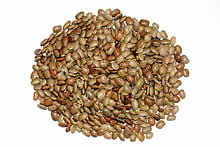Macrotyloma uniflorum

Macrotyloma uniflorum (horse gram, kulthi bean, hurali, Madras gram[2]) is a legume native to tropical southern Asia, commonly grown for horse feed and occasionally for human consumption and in Ayurvedic cuisine.[citation needed] Horse gram is grown in Andhra Pradesh, Bihar, Chhattisgarh, Himachal Pradesh, Jharkhand, Karnataka, Madhya Pradesh, Maharashtra, Orissa, Tamil Nadu, Uttarakhand, Jammu and Kashmir, and West Bengal in India, as well as in Malaysia, Sri Lanka, the West Indies, and elsewhere.[3] It is consumed as a whole seed, as sprouts, or as whole meal in India, popular in many parts of India. Medical uses of these legumes have been discussed.
Macrotyloma uniflorum is a perennial climbing plant with a rhizome, growing to a height of about 60 cm (24 in). The stem sprouts from the rhizome each year. It is clad in varying amounts of whitish hairs and bears alternate, trifoliate leaves with petioles up to 7 cm (2.8 in) long. The leaflets are obovate or elliptical, and up to 7 cm (2.8 in) long. The flowers are borne in twos or threes in the leaf axils, and are typical of the bean family with banner, wings and keel. They are cream, yellowish or green, often with a purple blotch inside. These are followed by linear-oblong, upcurving pods up to 8 cm (3.1 in) long, containing up to ten reddish-brown, speckled or black seeds.[4]
Horse gram is native to tropical southern Asia and has been found in archaeological sites in India, starting from 2500 BC.[5] It was probably first domesticated in India, and is now grown as a legume from India to Myanmar. It is also grown for fodder and as a green manure crop in tropical countries in southeastern Asia, and in northern Australia.[4]
Horse gram thrives where the temperature is in the range 20 to 30 °C (68 to 86 °F) but is killed by frost. It is a drought tolerant crop and is mostly grown in areas with under 900 mm (35 in) of precipitation, and even as little as 380 mm (15 in). In wetter areas, it is usually sown at the end of the wet season, to grow and crop in the dry season.[4]
